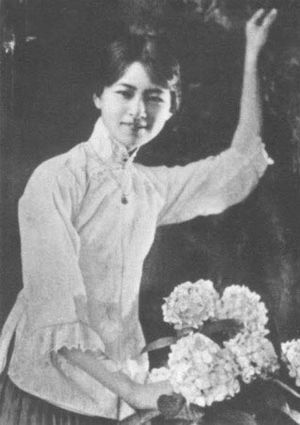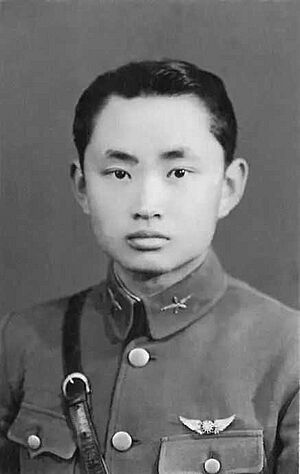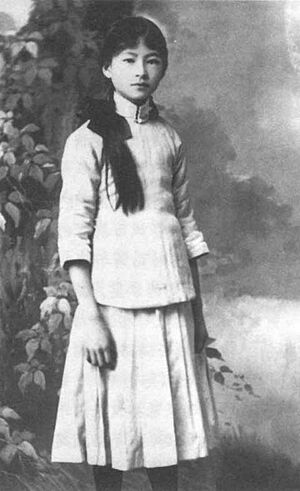Lin Huiyin facts for kids
Quick facts for kids
Phyllis Lin
|
|
|---|---|
 |
|
| Born | 10 June 1904 |
| Died | 1 April 1955 (aged 50) Beijing Tongren Hospital, Beijing, People's Republic of China
|
| Resting place | Babaoshan Revolutionary Cemetery |
| Alma mater | University of Pennsylvania |
| Occupation | architect, poet |
| Spouse(s) | Liang Sicheng, m. 21 March 1928, wid. 1 April 1955 |
| Children | Liang Congjie Liang Zaibing |
| Relatives | Liang Qichao (father-in-law) |
Lin Huiyin (Chinese: 林徽因, born 林徽音; pinyin: Lín Huīyīn), also known as Phyllis Lin, was a famous Chinese architect and architectural historian. She was born on June 10, 1904, and passed away on April 1, 1955. She is known as the first female architect in modern China.
Lin Huiyin and her husband, Liang Sicheng, were both important figures in Chinese architecture. Liang Sicheng is even called the "Father of Modern Chinese Architecture". They both helped start the Architecture Department at Northeastern University in 1928. Later, they became professors at Tsinghua University in Beijing.
Lin and Liang started working to restore China's old buildings and cultural sites after the imperial era ended. This became a lifelong passion for Lin Huiyin. The American artist Maya Lin is her niece.
Contents
Early Life and Education
Lin Huiyin was born in Hangzhou, China. Her family came from Minhou County. Her father was Lin Changmin, and her mother was He Xueyuan.
Because her family was wealthy, Lin Huiyin had a chance to get a good education. This was special because, at that time, many women did not have access to formal schooling. She traveled a lot with her father and studied in both England and the United States.
Lin first studied in London, England, at St Mary's College. While there, she met the well-known Chinese poet Xu Zhimo. Their friendship became a famous part of her life.
Studying Architecture and Arts
In 1924, Lin Huiyin and Liang Sicheng, who she had known since childhood, both enrolled at the University of Pennsylvania in the United States. Lin wanted to study architecture, but she was not allowed into the School of Architecture because she was a woman. Instead, she enrolled in the School of Fine Arts.
Even though she couldn't officially study architecture, she took many architecture classes. This allowed her to follow her passion for designing buildings. Later, she also studied stage design at Yale University, showing her interest in drama.
In April 1924, the famous Indian poet Rabindranath Tagore visited China. Lin Huiyin and Xu Zhimo worked together as his interpreters. Lin Huiyin impressed everyone with her excellent English and earned the poet's admiration.
Career and Contributions
After returning to China, Lin Huiyin helped create the Architecture Department at Northeastern University in Shenyang. She taught architecture there for a short time. In 1928, she designed a railway station in Jilin, which was one of the few buildings she designed herself.
Throughout the 1930s, Lin and her husband lived in Beiping, which is now called Beijing. They were close friends with American scholars Wilma and John K. Fairbank. These friends admired how Lin balanced Chinese traditions with new ideas from other countries.
Exploring Ancient Chinese Architecture
In 1936, Lin Huiyin and her husband climbed onto the roof of the Temple of Heaven to study ancient Chinese architecture. She was the first woman to walk on the roof of the emperor's palace.
In 1937, she made an important discovery. She found the main hall of Foguang Temple in Shanxi. This hall was the only known wooden building from the Tang Dynasty still standing at that time. This discovery was very important for understanding ancient Chinese building methods.
Wartime Challenges and Later Work

When Japan invaded China, Lin Huiyin and her husband had to stop their work on restoring Beijing's historical sites in 1937. They left their home in Beijing and moved south with their university department. They lived in different cities like Tianjin, Kunming, and finally Lizhuang in 1940.
While in Lizhuang, Lin Huiyin became very ill with tuberculosis. During this time, she learned that her younger brother, Lin Heng, had died as a pilot in the air force while defending Sichuan. She wrote a moving poem to remember him.
After 1949, Lin Huiyin became an architecture professor at Tsinghua University. She helped rebuild Beijing by focusing on its cultural history, architectural beauty, and the needs of its people. She also helped design the "National Emblem" and the "Monument to The People's Heroes." She designed the beautiful floral patterns at the base of the Monument to the People's Heroes. Lin also helped plan how Beijing would be organized.
She passed away in 1955 from tuberculosis.
Literary Works
Lin Huiyin was also a talented writer, known for her many poems and essays. She was an important female voice in the May Fourth Movement, a time of great change in China. Her writings are full of deep feelings and have a musical quality, like traditional Chinese poetry.
When she was young, Lin Huiyin traveled to Europe with her father. In England, she met Xu Zhimo, who encouraged her to write poetry and other literary works. They often worked together, organizing events and performing plays. When Rabindranath Tagore visited China, Lin and Xu translated for him, learning from the great poet. Lin became even more famous when she played the main role in Tagore's play "Chitra".
Lin Huiyin had a strong understanding of literature, and her poems covered many different topics. She often wrote about human love, the quiet beauty of nature, and the strength of life.
Legacy
In October 2010, a six-hour documentary about Lin Huiyin and her husband, called Liang Sicheng Lin Huiyin, was shown on CCTV. This helped bring new attention to their achievements.
Even though Lin Huiyin might not have received enough recognition during her lifetime because she was a woman, her legacy is now being celebrated. People say that while women are often seen through the achievements of men, Lin Huiyin is different. She shines brightly on her own and even adds to the brilliance of the many talented men around her.
In 2018, The New York Times wrote a special obituary for Lin Huiyin and her husband, recognizing their important contributions many years later.
Images for kids
-
Lin Huiyin with her son Liang Congjie
-
Lin Huiyin, Rabindranath Tagore and Xu Zhimo
See also
 In Spanish: Lin Huiyin para niños
In Spanish: Lin Huiyin para niños











